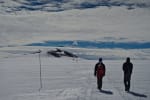It was a busy week at the Pole. There are always lots of preparations to be made before hunkering down for the many months of isolation and darkness. With the busy airfield, IceCube winterover Raffaela was out helping park a Herc. […]
News
Week 5 at the Pole
The summer season is nearing its end. So IceCube’s winterovers were busy helping summer crew wrap up their tasks. That included some cleaning and recabling in the ICL. […]
Week 4 at the Pole
IceCube winterover Raffaela got to see some amazing wildlife on her break, but check out what Johannes spotted on his R&R trip to McMurdo. That’s an icebreaker, which is needed to cut channels through the thick sea ice to allow fuel and cargo vessels to reach McMurdo Station. […]
Week 3 at the Pole
When you see mountains and wildlife, you know we’re not at the South Pole anymore. But we are still in Antarctica, and these first few images are from IceCube winterover Raffaela’s R&R trip to McMurdo. […]
Week 2 at the Pole
Since the winterovers spend a full year at the Pole, they get to fit in some R&R at McMurdo Station on the coast before the long stretch of winter isolation sets in. IceCube winterover Raffaela was off last week, after a two-day flight delay, leaving Johannes to hold down the fort on his own. […]
Week 1 at the Pole
The IceCube detector started out the year with no major issues. Yay! But there was plenty of excitement in other arenas. Everyone gathered at the geographic South Pole for the unveiling of the new pole marker. […]
Week 52 at the Pole
Last week was the third annual “Bermingman,” where folks go out into the berms to dig for buried treasure. Things are buried because of accumulated snow, not from actual snowfall but from storms and winds that blow in and deposit snow. In fact, just after the Bermingman, a huge wall of snow appeared on the horizon […]
Week 51 at the Pole
If you didn’t have snow over your holidays, you can enjoy it vicariously through these South Pole pictures. They had all kinds of fun in the snow—sledding and tubing, snowmobiling, and running! The sledding worked up their appetite for celebrations. […]
Week 50 at the Pole
Last week was a busy one at the Pole. A lot of holiday preparations and some visitors on station, including folks from Arctic Trucks, getting a station tour and giving tours of their vehicles. […]
Do fast radio bursts emit high-energy neutrinos?
Although fast radio bursts’ (FRBs) progenitors are supposed to be compact and perhaps catastrophic cosmic events that may also produce neutrinos, IceCube has not detected any such neutrinos that could be associated with a known FRB in six years of data. These results are far from precluding the eventual detection of neutrinos from FRBs in the future, but they have set the best limits yet on how many are emitted. The results have been submitted today to ”The Astrophysical Journal”. […]









